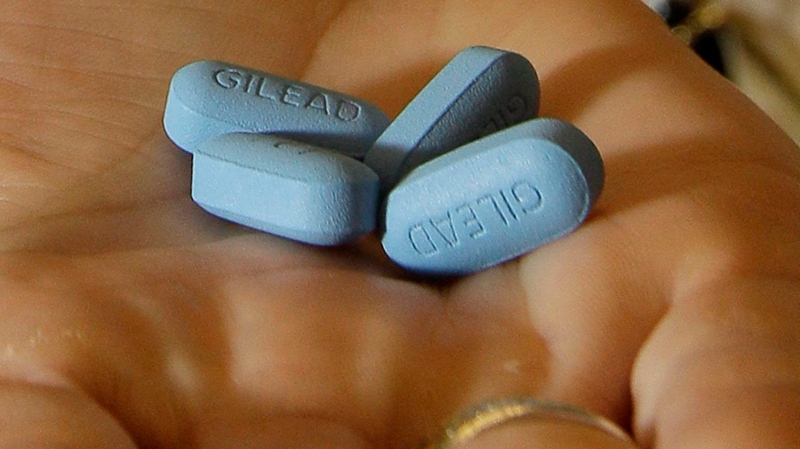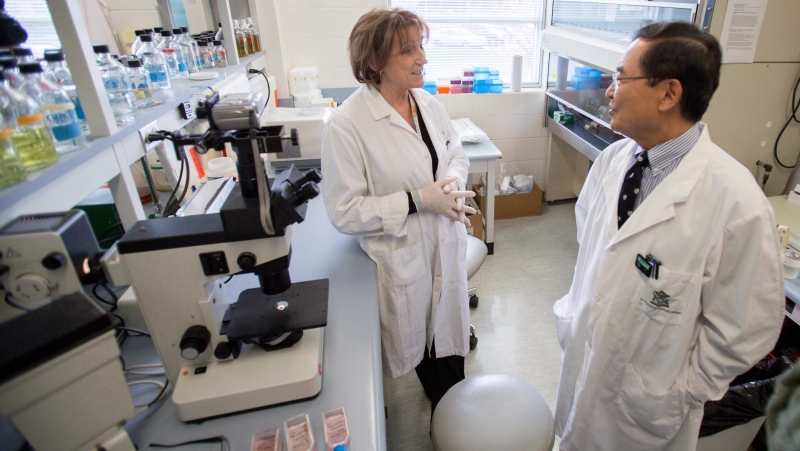Although advances in treatment have transformed HIV-AIDS from a deadly disease into a chronic, manageable condition, the fight against the pernicious virus is by no means over.
“We now have the tools to beat AIDS,” Toronto-based HIV-AIDS activist Tim McCaskell told �鶹Ӱ��. “What is distressing and infuriating is that those tools are not available to millions of people who need them.”
CANADA AND THE UNAIDS 90-90-90 TARGET
In 2014, the Joint United Nations Programme on HIV-AIDS (UNAIDS) launched its ambitious , which, by 2020, aim to see 90 per cent of people with HIV diagnosed, 90 per cent of those on treatment and 90 per cent of treated individuals achieving viral suppression, which means they can no longer pass on the virus. The ultimate goal of these targets is to end the HIV-AIDS epidemic by 2030.
“We have the tools, we just have to act on them,” Dr. Sean Rourke, a neuropsychologist at Toronto's St. Michael's Hospital who specializes in the neurobehavioural complications of HIV, told �鶹Ӱ��.
Rourke also serves as a member of the , which recently released a report entitled “.”
According to that report, of the estimated 63,100 people living with HIV in Canada, only 86 per cent have been diagnosed. Among that number, the report states, 81 per cent are on antiretroviral treatment and 91 per cent of them have achieved a suppressed viral load.
Despite some successes, according to the , the number of new HIV diagnoses is actually rising in the country, with more than 2,400 new cases being reported in 2017. That equals 6.5 new diagnoses every day, which is a three per cent increase over 2016 and a startling 17.1 per cent increase since 2014. In Canada, moreover, nearly half of all new cases -- or 45.3 per cent -- are reported in people over the age of 40.
Such numbers, Rourke says, shows how Canada’s progress is lagging behind that of other developed countries such as Australia and the United Kingdom.
“We want to see a more coordinated national effort on HIV and that’s just not there,” Rourke said. “It’s lack of will. We’ve been stagnant for five years or more… We need to get over the finish line.”
- The most significant breakthrough in HIV-AIDS treatment came in 1996 with the introduction of combination antiretroviral therapy, which uses two or more drugs to suppress viral replication, essentially keeping the HIV virus at bay, thus preserving a person’s immune system and making it incredibly difficult for them to transmit HIV to others. For more, see this story.
THE GLOBAL CONTEXT
Today, an estimated 36.9 million people are living with HIV worldwide. And while progress is being seen in many parts of the world, when it comes to testing and treatment, major geographical disparities still exist.
“Developing countries need a lot more than combination drug treatment -- they need entire healthcare system infrastructures established,” Dr. Philip Berger, who has been treating people with HIV in Toronto since the epidemic began, said. “AIDS is not unique that way, but it sharply illustrates the inequality and unfairness comparing countries like Canada to some countries in sub-Saharan Africa, for example.”

This Oct. 5, 2009 photo shows tuberculosis and HIV patients Sumbath Saiheng, left, and Wan Chalam sharing food at Wat Prabat Nampu in Lopburi, Thailand. (AP Photo/David Longstreath)
While things are finally -- albeit, gradually -- improving in sub-Saharan Africa, which was once the epicentre of the HIV-AIDS epidemic, other regions are lagging far behind. In particular, there have been no significant reductions in AIDS-related mortality in Eastern Europe and central Asia since 2010, while deaths from AIDS-related illnesses are actually now increasing in North Africa and the Middle East, according to UNAIDS. Bucking an overall global trend of declining infection rates, all four of these regions have also experienced a troubling doubling of new HIV infections over the past two decades.
“We are at the very beginning of a terrific success,” Dr. Julio Montaner, who leads HIV-AIDS research at the University of British Columbia, said. “But I have come to realize that unless our political leaders globally redouble the effort, we will not be able to get there, and in doing so, many, many more people are going to suffer the devastating effects of HIV-AIDS unnecessarily.”
- For a fuller look at the state of HIV-AIDS today, see the latest .
“AIDS is like a lens,” McCaskell, the Toronto activist, added. “When you look through this lens, you see all the problems in the world magnified… AIDS shows how inequality and injustice in the society that we live in in fact makes people more vulnerable to death when in fact they don’t need to be, because we have the means of treating this kind of illness.”
TREATMENTS OF TOMORROW
The most recent major development in the fight against HIV/AIDS was the 2012 introduction of pre-exposure prophylaxis (PrEP) drugs, which are most commonly sold under the brand name Truvada. Taken regularly by someone who is at risk of being infected, such as a person who has a partner that is living with HIV, these drugs make it virtually impossible for them to contract the virus.
- For more on the history of the HIV-AIDS epidemic, see this timeline.

In this May 10, 2012, file photo, a doctor holds Truvada pills at her office in San Francisco. (AP Photo/Jeff Chiu)
“If you take a (PrEP) pill every single day, you can decrease by greater than 97 per cent the likelihood that someone will acquire infection,” explains Dr. Anthony Fauci, an American immunologist who has been involved in HIV/AIDS research and treatment through the U.S. National Institutes of Health since the dawn of the epidemic.
The next major breakthrough in HIV treatment will be the introduction of intermittent therapy. While those on combination antiretroviral therapy today generally only need to take one or two daily pills, with intermittent therapy, people with HIV will be able to get the same type of medicine via semi-regular injections.
Rau calls this “the next revolution.”
“This could be very powerful for the some of the marginalized people,” he explained. “Especially in some of these poor countries that have poor healthcare systems, they just have to show up somewhere every two months. That’s easier than getting them to take pills every day.”
The first generation of intermittent therapy could be available as soon as next year -- but what HIV specialists are really looking forward to are injections that can be delivered twice a year.

Dr. Anthony Fauci of the National Institutes of Health listens to a question during an AP Newsmaker interview in Washington, Thursday, Jan. 18, 2018. (AP Photo/Susan Walsh)
“Not everyone likes to take their medication every single day and the reason why people blip and relapse is that they just go off their medications,” Fauci added.
A new type of treatment that can attack the virus itself -- potentially paving the way for a vaccine -- is also in the works.
“The other is what’s called passive transfer of broadly neutralizing antibodies that we’ve developed from individuals who have been infected,” Fauci explained. “The ultimate goal (is) of having someone come in and get an infusion of a combination of antibodies two or three times a year and that’s it.”
TOWARDS A CURE?
The Holy Grail for HIV-AIDS researchers is developing a vaccine or cure, and a lot of work to that effect is currently underway. But if the world is able to surpass UNAIDS’ 90-90-90 targets, many researchers believe that a vaccine or cure might not even be needed.

Western University immunologist Dr. Chil-Yong Kang, right, speaks to a colleague in his lab following a press conference announcing the successful completion of phase 1 clinical trials of his preventative HIV vaccine in London, Ont., Tuesday, November 6, 2012. (THE CANADIAN PRESS/ Geoff Robins)
“Theoretically, if you could access every single person who is infected with HIV and put them on antiretroviral therapy and get their viral load to below detectable levels, you could essentially end the epidemic tomorrow because nobody would ever infect anybody else,” Fauci explained.
If that were to happen, Fauci said, we would not need a 98 per cent effective vaccine like we have for things like measles and polio.
“If we could get something like a 50 to 60 per cent effective vaccine, together with all of the prevention modalities… I think we could probably really have a major impact on turning around the trajectory of the epidemic,” he said.
With files from CTV Medical Correspondent Avis Favaro and senior producer Elizabeth St. Philip




























